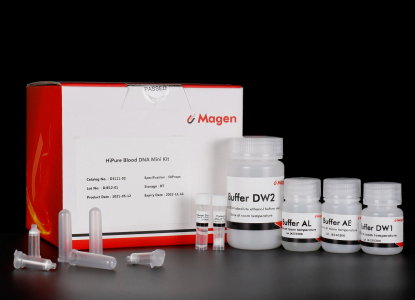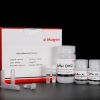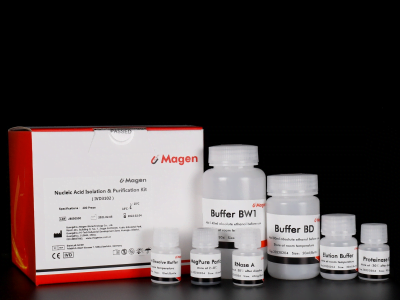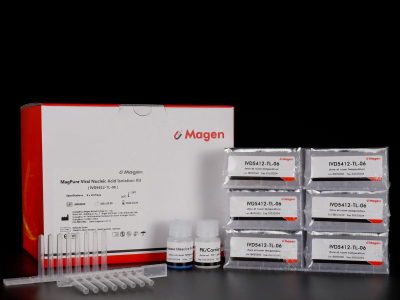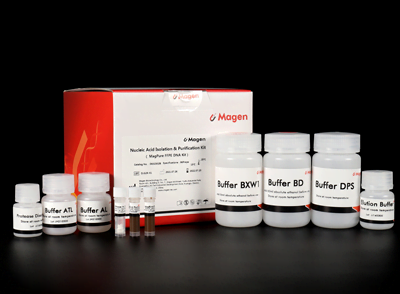Einführung
Blood is a valuable source of DNA for various clinical applications and research studies. Jedoch, extracting DNA from blood samples presents several challenges:
Safety Concerns:
- Blood samples can harbor pathogens, posing a risk of infection to researchers and contaminating the lab environment.
- Traditional methods often involve hazardous chemicals like phenol-chloroform.
DNA Loss:
- Removing red blood cells, a common pre-treatment step can lead to the loss of desired DNA fractions like viral DNA, zirkulierende DNA, and microbial DNA.
Impurities and Inhibitors:
- Blood contains various components that can interfere with downstream analyses like PCR und Southern Blot.
New Technology for Improved Blood DNA Extraction:
This product offers a novel approach to address these challenges:
- Safe and Efficient: The method eliminates the need for red blood cell removal, minimizing infectious waste and potential contamination.
- Comprehensive DNA Recovery: The protocol allows for the purification of total DNA, einschließlich Genomic, mitochondrial, viral, und zirkulierende DNA, providing a more complete picture for analysis.
- Breite Probenkompatibilität: The method effectively purifies DNA from various blood components like whole blood (frisch oder gefroren), Plasma, Serum, Buffy-Mantel, und mehr.
- Downstream-Anwendungen: The extracted high-quality DNA is suitable for reliable PCR and Southern blotting analyses.
This innovative solution simplifies blood DNA extraction while ensuring safety, efficiency, and comprehensive DNA recovery. It represents a significant advancement for researchers working in various fields like diagnostics, Forensik, and medical research.
Spezifikationen
| Merkmale | Spezifikationen |
| Hauptfunktionen | Isolierung der Gesamt-DNA aus 200 µl Vollblut |
| Anwendungen | PCR, Südlicher Bolzen und Virenerkennung, usw |
| Reinigungsmethode | Mini Spin-Säule |
| Reinigungstechnologie | Silica-Technologie |
| Prozessmethode | Handbuch (Zentrifugation oder Vakuum) |
| Beispielstyp | Vollblut (frisch oder gefroren), Serum, Plasma, Milch, Speichel, und andere flüssige Proben und kultivierte Zellen |
| Probenmenge | <200μl Vollblut oder andere flüssige Proben, <5*106 lymphocytes or Culture Cells Non-mammalian animals that have a nucleus in red blood cells (reich an DNA, wie Vögel und Fische): 5Etwa 20 μl Vollblut auf einmal. |
| Elutionsvolumen | ≥20μl |
| Zeit pro Lauf | ≤30 Minuten |
| Flüssigkeitstransportvolumen pro Säule | 800µl |
| Bindungsausbeute der Säule | 100µg |
Prinzip
Efficient DNA Purification with Silica Column Technology
This product utilizes a silica column-based method for rapid and efficient DNA purification. Here’s a breakdown of the process:
- Probe Lyse und Verdauung: The sample is treated with a lysate solution and protease to break down cell membranes and degrade proteins. Dies setzt DNA in die Lösung frei.
- Binding to Silica Membrane: The lysate containing the DNA is transferred to a silica column. The silica membrane in the column specifically binds DNA molecules through favorable interactions. Proteins and other impurities remain unbound.
- Waschen: Wash buffers are passed through the column, removing unbound proteins and cellular debris that did not adhere to the silica membrane.
- Elution: Endlich, a low-salt buffer (Typischerweise 10 MM Tris, pH 9.0, Und 0.5 MM EDTA) is used to elute the purified DNA from the silica membrane. This buffer disrupts the interaction between DNA and the silica, allowing the purified DNA to be collected in a separate tube.
Vorteile
- Hochwertige DNA – erfüllt eine Vielzahl nachgelagerter Anwendungen, inklusive PCR, qPCR, Enzymverdauung, Hybridisierung, usw.
- Schnell – ohne Trennung von Leukozyten, organische Extraktion, oder Ethanolfällung
- Einfach – Alle Nukleinsäuren können durch Direktverdau gewonnen werden
- Breite Anwendbarkeit- Umgang mit einer Vielzahl flüssiger Proben
Inhalt des Kits
| Inhalt | D311102 | D311103 |
| Reinigungszeiten | 50 | 250 |
| HiPure DNA Mini-Säulen I | 50 | 2 X 125 |
| 2ml-Sammelröhrchen | 100 | 5 X 100 |
| Puffer AL | 15 ml | 60 ml |
| Puffer DW1 | 30 ml | 150 ml |
| Puffer GW2* | 12 ml | 50 ml |
| Proteinase K | 24 mg | 120 mg |
| Protease-Auflösungspuffer | 1.8 ml | 10 ml |
| Puffer AE | 15 ml | 60 ml |
Lagerung und Stabilität
Für optimale Leistung:
- Store Proteinase K at 2-8°C (Kühlschrank) Bei der Ankunft.
Akzeptable kurzfristige Speicherung:
- Proteinase K can be stored for up to 12 Wochen bei Raumtemperatur (15-25°C) without affecting its performance.
Verbleibende Kit -Komponenten:
- Store all other components of the kit dry at room temperature (15-25°C).
- Sie sind zumindest stabil 18 Monate unter diesen Bedingungen.
Wichtiger Hinweis:
- If storing the entire kit at room temperature, ensure buffers are redissolved before use and always warm all buffers to room temperature before using them.
